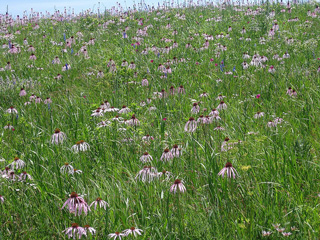Resource Library
Plant of the Week: Prairie, Baker
Plant of the Week
Baker Prairie, Harrison, Arkansas
 Pale purple coneflower is one of the wildflowers on display in early June at Harrison’s
Baker Prairie. (Image courtesy Gerald Klingaman)
Pale purple coneflower is one of the wildflowers on display in early June at Harrison’s
Baker Prairie. (Image courtesy Gerald Klingaman)
Download High Resolution
Being a native son of Oklahoma and its rolling prairies, I have a real fondness for these natural ecosystems. Because prairies usually existed on open land they were prime places for farming and development, so few undisturbed natural prairie ecosystems exist in Arkansas, a state usually associated with forests not prairies. Baker Prairie, within the city limits of Harrison, Arkansas, is a 71-acre remnant of an Ozark highlands tallgrass prairie that is worth a visit.
Baker Prairie is jointly managed by the Nature Conservancy and the Arkansas Natural Heritage Commission. The tract was purchased from the Majors family in 1993. It is located on Goblin Drive in the southwestern part of the Ozark city adjacent to the high school. Goblin Drive bisects the prairie so be sure to visit both sides to see all the area has to offer. Parking is in the high school parking lot and a mowed path meanders through the grassland.
Tallgrass prairies are dominated by grasses with little bluestem and indiangrass dominating the drier, higher places on Baker Prairie while big bluestem and switchgrass are more common in more moist locations. The grasses will be in the 3- to 4-foot range, but by fall it can be head high in places.
While grasses are fascinating plants, it is the forbs that attract the most attention. Forbs are the herbaceous, non-grass inhabitants of a prairie. We could use the term “wildflower” but wildflowers also occur in the woods amongst trees whereas forbs are specific to grassland communities. About 150 native species of prairie plants occur there with bloom time ranging from early spring through the fall. Six species – the Ozark wake robin (Trillium), prairie violet, royal catchfly, downy gentian, silky aster, and early goldenrod – are rare plants in the state and occur there.
The survival of a prairie is a tenuous thing because open land is easy to lose. The biggest threat to the existence of a prairie – other than development – is the encroachment of trees. Hundred- year-old photos I’ve seen of my home in Oklahoma show vast open prairies with nary a tree in sight. Today, the prairie has been transformed by trees of all sorts crowding in and shading out the native grasses. Only the prairie hay meadows that have never been plowed and are mowed every year remain to remind one of what once was.
Fire is the time-honored way of keeping prairies free of trees. The Baker Prairie is burned every few years to keep the trees at bay and to replenish the soil with minerals from the conflagration.
There is no best time to visit any natural area because each season has its own rewards. To really know an area it must be visited throughout the year to unravel its secrets. Wildflowers are fickle things. Sometimes a species will skip a year or two before coming back in the kind of knock-your-socks off display that is easy to miss. The Friends of Baker Prairie is a local Harrison group that maintains an interactive website that illustrates which wildflowers are likely to be in bloom during the various seasons.
By: Gerald Klingaman, retired
Retired Extension Horticulturist - Ornamentals
Extension News - May 29, 2014
The University of Arkansas System Division of Agriculture does not maintain lists of retail outlets where these plants can be purchased. Please check your local nursery or other retail outlets to ask about the availability of these plants for your growing area.